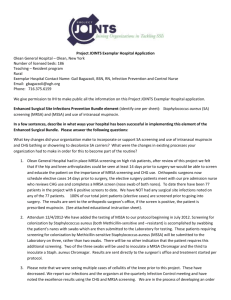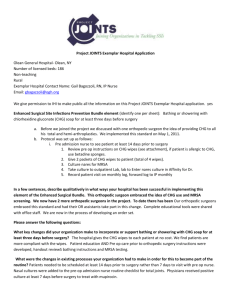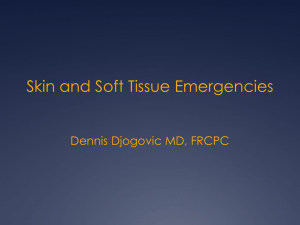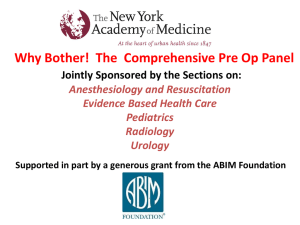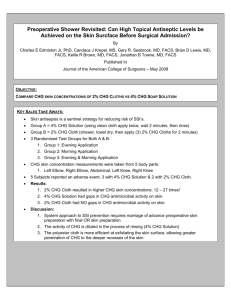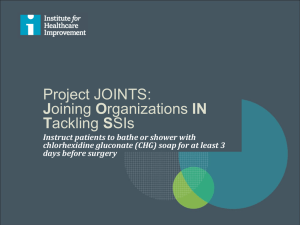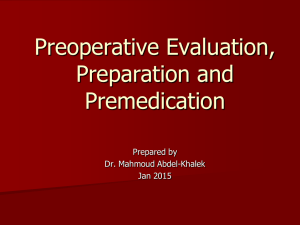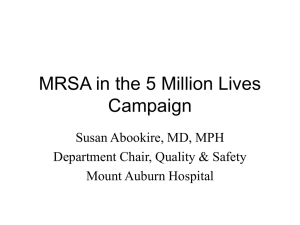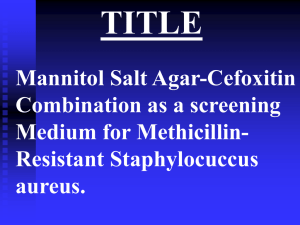Kathy Duncan - Washington State Hospital Association
advertisement
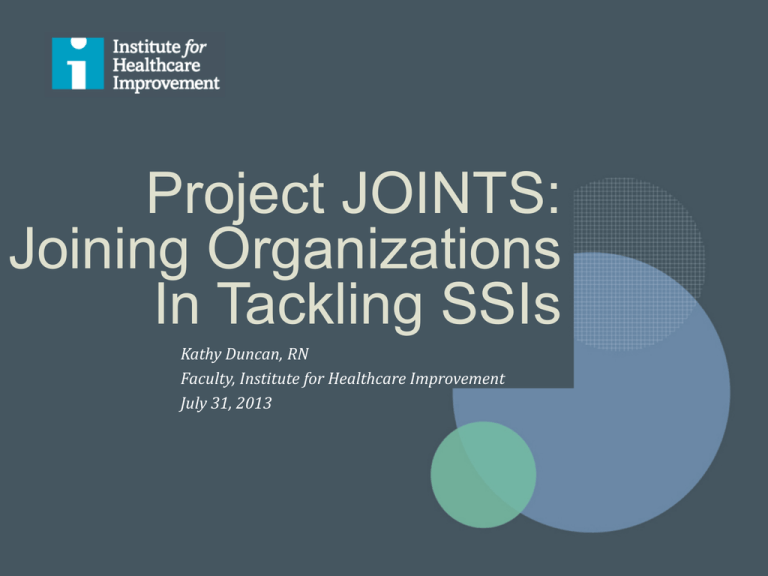
Project JOINTS: Joining Organizations In Tackling SSIs Kathy Duncan, RN Faculty, Institute for Healthcare Improvement July 31, 2013 What is Project JOINTS? An initiative funded by the federal government to give participants support from IHI in the form of in-person and virtual coaching on how to test, implement and spread the enhanced SSI prevention Bundle comprised of three new Evidence-based Practices as well as the two applicable Surgical Care Improvement Project (SCIP) practices. Two cohorts of 5 states with a 6 month intervention period. (May 2011-October 2012) Presented at Washington State Hospital Association, Safe Table 7/31/13 2 Initial States Participation Presented at Washington State Hospital Association, Safe Table 7/31/13 3 Support & Contributions 4 American Academy of Orthopaedic Surgeons (AAOS/Academy) – “The JOINTS project is a remarkable endeavor and the Academy looks forward to working with you to accomplish the goal of eliminating preventable SSIs.” AORN Hospitals already engaged in the “new” interventions. Presented at Washington State Hospital Association, Safe Table 7/31/13 Project JOINTS Offer implementation support to participants on the recommended interventions to reduce prevent hip and knee SSIs Build a network of facilities that are working together toward the same aim – literally Joining Organizations IN Tackling SSIs Test IHI’s ability to spread evidence-based practice Presented at Washington State Hospital Association, Safe Table 7/31/13 7 AAOS Annual Meeting 2013 Award of Excellence at the March American Academy of Orthopaedic Surgeons 2013 Meeting: “Reducing Surgical Site Infections in Total Joint Arthroplasty: It’s a War and not Just One Battle”. doctors Brian Hamlin and Tony DiGioia III. Presented at Washington State Hospital Association, Safe Table 7/31/13 SSI Prevention For Hip and Knee Arthroplasty New Practices: – Use of an alcohol-containing antiseptic agent for pre-op skin prep – Pre-op bathing or showering with chlorhexidine gluconate (CHG) soap for at least 3 days prior to surgery – Staph aureus screening and use of intranasal mupirocin and CHG bathing or showering to decolonize staph aureus carriers Applicable SCIP practices: – Appropriate use of prophylactic antibiotics – Appropriate hair removal Presented at Washington State Hospital Association, Safe Table 7/31/13 Use an alcohol-containing antiseptic agent for preoperative skin preparation 9 Adequate preoperative skin preparation to prevent entry of skin flora into the surgical incision is an important basic infection prevention practice. Preoperative skin preparation of the operative site involves use of an antiseptic agent with long-acting antimicrobial activity, such as chlorhexidine and iodophors. Two types of preoperative skin preparations that combine alcohol (which has an immediate and dramatic killing effect on skin bacteria) with long-acting antimicrobial agents appear to be more effective at preventing SSI than povidone-iodine (an iodophor) alone: –CHG plus alcohol – Iodophor plus alcohol . Presented at Washington State Hospital Association, Safe Table 7/31/13 Use an alcohol-containing antiseptic agent for preoperative skin preparation 10 Behavioral Objective: Change the operating room skin prep for hip and knee arthroplasty to a long-acting antiseptic agent in combination with alcohol. Assess your current process and potential barriers: Identify surgeons currently using an alcohol-based skin prep to champion the change in practice with their peers. Determine the high-volume surgeons and focus your efforts on working with them. Conduct brief interviews with representative surgeons to identify any misconceptions or key barriers to using an alcohol-based skin prep. Provide a brief summary of the scientific evidence supporting change to an alcohol-containing skin prep to influence change of habit/tradition. Presented at Washington State Hospital Association, Safe Table 7/31/13 Changes in Practice 11 Ensure the alcohol-based skin prep is applied correctly: – Skin prep should be completely dry prior to draping. – Cleanse the incision area for 30 seconds and then paint the rest of the extremity. – Consider use of a tinted CHG-alcohol prep (orange or teal) for greater visibility. – Avoid pooling of the skin prep. Incorporate alcohol-based skin prep into the individual surgeons’ preference cards as agreement is reached regarding use of alcohol-based skin prep Presented at Washington State Hospital Association, Safe Table 7/31/13 Ask Patients to bathe or shower with CHG soap for at least 3 days prior to surgery 12 Studies show that repeated use of CHG soap for bathing or showering results in progressive reductions in bacterial counts on the skin Patients may benefit from bathing or showering with CHG soap for at least 3 days before surgery in order to achieve the most benefit. It is unknown whether using CHG soap for longer time periods (e.g., five days) has additional benefit. No clear evidence that CHG bathing reduced the risk of SSI, although most studies used only 1-2 applications of CHG washes. – Webster J, et al, Cochrane Database of Systematic Reviews 2007, Issue 2. Art. No.: CD004985. DOI: 10.1002/14651858.CD004985.pub Presented at Washington State Hospital Association, Safe Table 7/31/13 Ask patients to bathe or shower with chlorehexidine gluconate (CHG) for at least 3 days prior to surgery 13 Behavioral Objective: Provide patients with chlorhexidine soap, and have them use the soap in bathing or showering for at least three days before surgery. Assess your current process and potential barriers: Assess where most preoperative assessments take place Assess current preoperative communication between the hospital OR department and the offices of orthropaedic surgeons inside and outside the hospital. Tailor the implementation process to your setting Develop a process flow diagram to define all components of the process Presented at Washington State Hospital Association, Safe Table 7/31/13 Key Concepts to Consider Patients must understand why CHG bathing is important Patients need to understand how to do CHG bathing Access to CHG for pre-op bathing How will we know if CHG baths were completed? Presented at Washington State Hospital Association, Safe Table 7/31/13 Lessons Learned • Pre-Op class – Weekly, same time, same place – Discuss processes – Multidisciplinary – Education materials – (Screening for MSSA and MRSA) Education Material – What product to use, provide if possible – How to use CHG Measure: How many patients completed the 3 baths prior to surgery – How many patients completed the 3 baths prior to surgery – Checklists – Admit process/holding area Presented at Washington State Hospital Association, Safe Table 7/31/13 15 16 Presented at Washington State Hospital Association, Safe Table 7/31/13 17 Presented at Washington State Hospital Association, Safe Table 7/31/13 Screen patients for Staphylococcus aureus (SA) carriage and decolonize carriers with 5 days of intranasal mupirocin and at18 least 3 days of CHG prior to surgery Patients who carry SA in their nares or on their skin are more likely to develop SA SSIs. This is true for methicillin-resistant as well as methicillin-sensitive – – SA.Kluytmans et al, J Infect Dis 1995;171:216-9 Huang SS, Platt R. Clinical Infectious Diseases. 2003;36(3):281-5. The combination of intranasal mupirocin and CHG bathing or showering eliminates SA, at least temporarily, from the nares and skin, the natural reservoirs where SA is most often carried Results of several studies, including studies in orthopedic surgery, suggest that preoperative intranasal mupirocin reduces the risk of SSI for SA carriers. – – Kalmeijer MD, et al, Clin Infect Dis. 2002;35(4):353-8 van Rijen MM, et al, J Antimicrob Chemother 2008;61(2):254-261 Presented at Washington State Hospital Association, Safe Table 7/31/13 Screen patients and Decolonize SA carriers w/5 days intranasal mupirocin & 3 days CHG 19 Behavioral Objective: Screen all patients for Staphylococcus aureus prior to surgery, allowing enough time for those who screen positive to be decolonized with five days of intranasal mupirocin. Assess your current process and potential barriers: Assess where most preoperative assessments take place Tailor the intervention to the setting in which preoperative assessment is done Work with Lab to assure screening includes both MRSA and MSSA Develop a process to assure info on screening and decolonization is available at the time of surgery Develop a process flow diagram to define components of the process Presented at Washington State Hospital Association, Safe Table 7/31/13 Key Concepts to Consider Assess your current process and potential barriers Tailor the intervention to the setting in which the preoperative assessment is done Work with your laboratory – to ensure screening includes MSSA and MRSA and notification process – Understand culture/PCR process, possibilities and barriers – (PDSA) follow one class – thru notification process Presented at Washington State Hospital Association, Safe Table 7/31/13 20 Key Concepts to Consider 21 Develop a process to ensure information on screening and decolonization is available prior to the time of surgery – (PDSA) follow one class – thru notification process – Test processes to provide mupirocin prescription – How do you assess compliance? Develop a process flow diagram – Define components (from your tests) Presented at Washington State Hospital Association, Safe Table 7/31/13 For Example: Screening Costs, Adapted process COST FOR RAPID MRSA AND MSSA IS $50.33 WITH A TURN AROUND TIME (TAT) OF 75 MINUTES COST OF RAPID MRSA ONLY IS $40.24 WITH SAME TAT COST OF ROUTINE MRSA AND MSSA CULTURE IS $7.77 WITH A TAT OF 24-48 HOURS Presented at Washington State Hospital Association, Safe Table 7/31/13 Lessons Learned 23 Incorporate screening for SA and prescribing mupirocin into surgeons’ preoperative assessment orders Build on established preop assessment processes that require patient follow-up/treatment before surgery, such as positive urinalysis/urine culture requiring antibiotic treatment If PCR testing is available, assess the feasibility of providing screening results and prescription if needed, at the preop visit Create a flag system to be used during surgery for patients testing positive for MRSA to ensure Vancomycin is used preop Presented at Washington State Hospital Association, Safe Table 7/31/13 24 (Sparrow Hospital, Lansing, Michigan, USA) Presented at Washington State Hospital Association, Safe Table 7/31/13 (Exempla Lutheran Medical Center, Wheat Ridge, Colorado, USA) 25 Presented at Washington State Hospital Association, Safe Table 7/31/13 Screening results- Canton Potsdam 2011 Volume = 110 Known MRSA: 2= 2% MRSA: 3= 3% MSSA: 16= 15% Total MRSA & MSSA: 21= 21 % Captured with nasal screen = 19% MRSA 2= 1.4% MSSA 19= 13% Total MRSA & MSSA : 21= 14.4% Captured with nasal screen = 14.4% 2013 Volume = 22 Known MRSA: 2= 10% MSSA: 4= 18% Total MSSA & MRSA: 6= 28% Captured with nasal screen= 18% 2012 Volume = 146 Known MRSA: 0= 0% Presented at Washington State Hospital Association, Safe Table 7/31/13 Mercy St Joseph’s -JOINT PROGRAM 4.5 4 4.26 3.64 3.5 3 2.5 2.19 2 2.04 1.5 1 Infection Rates –Goal was to decrease by 50% 0.5 0 Total Hip Total Knee Presented at Washington State Hospital Association, Safe Table 7/31/13 2010 2011 28 UT Medical Center 2 1.8 1.6 1.4 Implemented all recommendations of Project JOINTS in Spring/Summer 2011. 1.2 1 0.8 0.6 0.4 2010 0.2 0 Hips Knees Presented at Washington State Hospital Association, Safe Table 7/31/13 2012 Holy Family Memorial-Manitowoc, WI Total Joint Patient August 2012 – March 2013 156 Patients 8/156 – 5.1% - Positive for MRSA 34/156 – 21.7% - Positive for SA ZERO Hip Infections! 0.46 Knee Infection Rate! Presented at Washington State Hospital Association, Safe Table 7/31/13 29 Resources – www.ihi.org/projectjoints Presented at Washington State Hospital Association, Safe Table 7/31/13 Exemplar Hospitals Presented at Washington State Hospital Association, Safe Table 7/31/13 32 Surgery Data Tracker Presented at Washington State Hospital Association, Safe Table 7/31/13 Resources for you Call series How-to Guide Business case Patient instruction sheets and checklists Protocols for staff Evidence 1-pager Over 30 exemplars Listserv Presented at Washington State Hospital Association, Safe Table 7/31/13 Questions?
